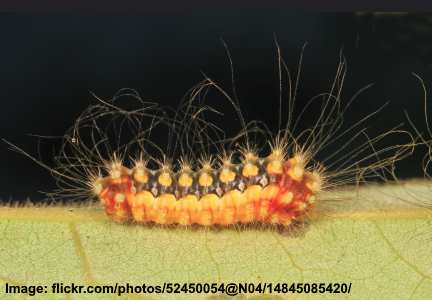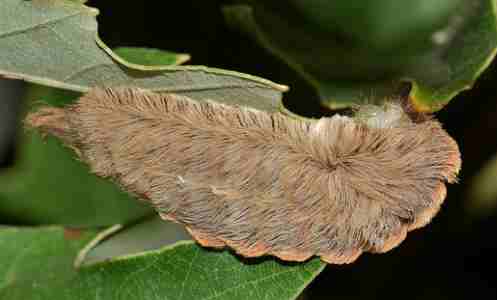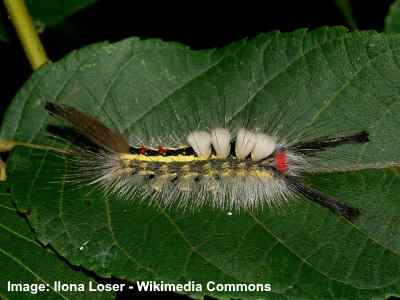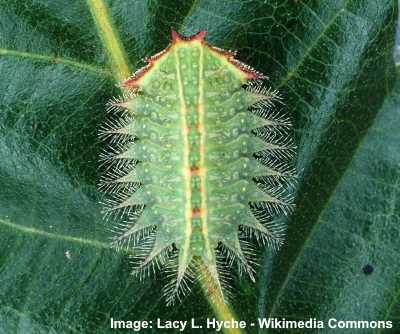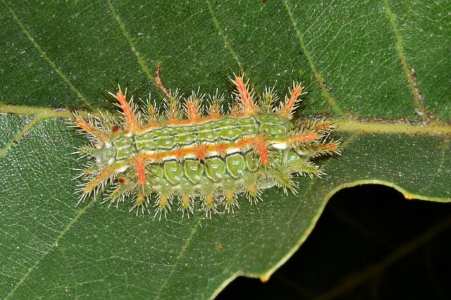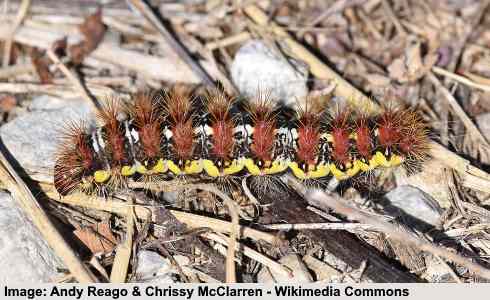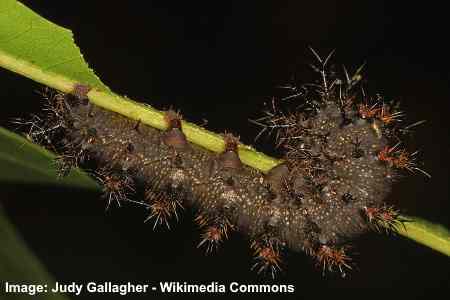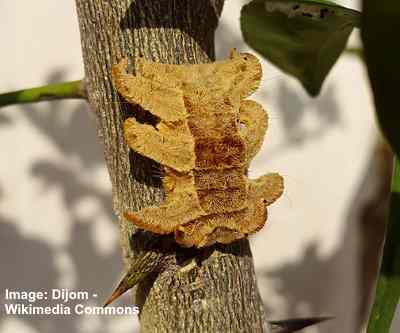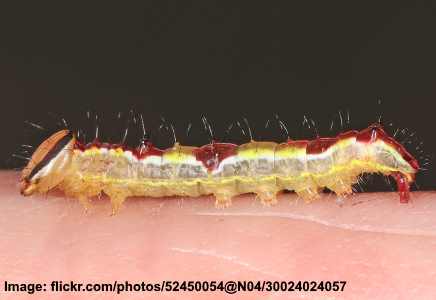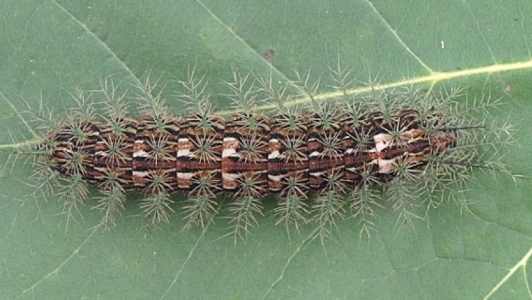16 Stinging Caterpillars: An Identification Guide With Pictures
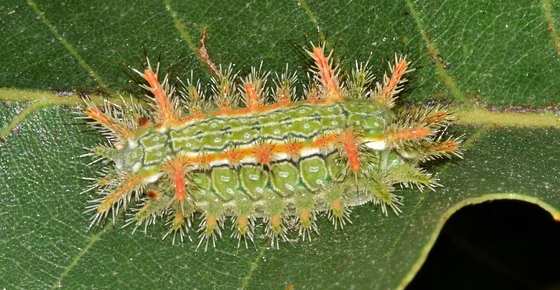
While most types of caterpillars are harmless, there are some species of stinging caterpillars. Caterpillars that sting are generally hairy or have spikes on their bodies. Handling one of these dangerous caterpillars could leave you with a nasty sting similar to a bee’s sting. Before picking up any kind of caterpillar, it is important to identify the species to know if it is harmless or not.
All caterpillars are larvae that belong to the order of moths and butterflies called Lepidoptera in the class of Insecta. After hatching from eggs, caterpillars are ravenous eaters and mainly consume plant and tree leaves. Although not all species of caterpillars are venomous, they can do tremendous damage to plant foliage.
Many caterpillar species have developed various defense mechanisms, including horns, spines, venomous spines, secretions, and body hairs.
Caterpillar Identification
To identify caterpillars, it is important to take note of their size, color, type of bristles or spines, and habitat. Some other insect larvae can look similar to moth or butterfly larvae. You can tell these apart because caterpillars have a maximum of 5 pairs of prolegs. Other types of crawling bugs may have more. Most stinging caterpillars are identified by spine or fine hairs covering their body.
It is important to remember that caterpillars go through many stages of growth before they become moths or butterflies. This means that immature larvae can look different from caterpillars just before the pupation stage. The descriptions of stinging toxic caterpillars in this list are of mature larvae.
How Can You Tell if a Caterpillar is Venomous?
Just because a caterpillar looks spiky, hairy, fuzzy, or furry doesn’t automatically mean it’s dangerous. How do some hairy caterpillars hurt you? Do venomous caterpillars sting?
The University of Florida says that some caterpillar species have stinging hairs called urticating hairs. These are barbed bristles or spines that can lodge in your skin and break off. This can cause irritation similar to handling fiberglass. So, stinging caterpillars don’t sting in the same way that wasps or bees sting. (1)
Also, the spikes or spines of some stinging caterpillar species contain toxins. These are slowly released when caterpillar hairs sting a person. The result in some people can be allergic reactions such as itching, nausea, blistering, or even abdominal upset. (2)
Although people refer to a ‘caterpillar bite,’ they are actually talking about the stinging sensation from urticating caterpillar hairs.
There is also a species of venomous caterpillar in South America that is so toxic that its ‘sting’ has been known to cause death. (3)
So, before picking up an exotic looking caterpillar, you should identify the species to see if it is a stinging kind.
Types of Stinging Caterpillars with Names and Pictures – Identification Guide
Let’s look in more detail at how to identify species of caterpillars that are known to sting and cause skin irritation.
Stinging Rose Caterpillar (Parasa indetermina)
One of the most colorful stinging larvae is the Stinging Rose caterpillar (Parasa indetermina). Brushing against this type of caterpillar can leave you with an itchy, irritating rash.
This caterpillar is identified by clusters of bright yellow spines sticking out from its body. There are prominent spiky horns along its side, front, and rear. Some types of these larvae have red-colored bodies with rows of purple or black stripes along their back. Others are a type of yellow caterpillar that have white and blue stripes.
Stinging Rose caterpillars are found in Florida, Texas, Oklahoma and other states on the Eastern coast of the US. They love to feed on apple, hickory, oaks, and maples. It is their preference of munching rose bushes that gives them their common name.
Identifying features
Ranging in colors from yellow to green to red, the Stinging Rose caterpillar has clusters of spiny horns covering its soft body.
- Adult Stage: Stinging Rose Caterpillar transforms into the Rosy Maple Moth (Dryocampa rubicunda).
- Host Plants: The caterpillar feeds on a variety of plants, including roses (which accounts for its common name ‘stinging rose’), as well as elms, dogwood, apple, cherry, oak, poplar, maple, hickory, and bayberry
- Habitat and Distribution: Found in gardens, forests, and urban areas across North America.
Io Moth Caterpillar (Automeris io)
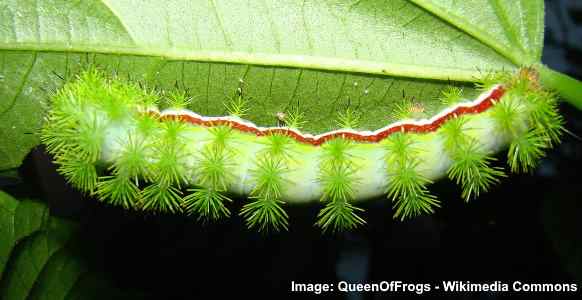
The Io moth caterpillar has green spikes that feel very unpleasant if their venom penetrates your skin
The Io moth caterpillar (Automeris io) is covered in tufts of green spikes that look like pine needles. The spines are connected to poison glands. These spines have venom that can cause skin irritation, pain, and other allergic reactions if they come into contact with your skin.
The spines contain toxic substances that cause a lot of skin irritation
This green type of caterpillar starts life as orange worm before turning lime green. You can identify this species by the red and white stripes running the length of its side. Green spikes stick out from all parts of its body. There are even tiny spikes on the 4 pairs of prolegs on its central segments.
The urticating spines can give you a nasty “bite” if the venom gets into your skin. Even just the slightest touch of these stinging caterpillars can cause a lot of pain that lasts an hour or so.
Identifying features
Protruding light green spikes covering a green body are a warning sign not to handle this caterpillar.
- Adult Stage: Io Moth Caterpillar transforms into the Io Moth (Automeris io).
- Host Plants: The caterpillar primarily feeds on a variety of broadleaf trees and shrubs, including corn, roses, willow, linden, elm, oak, locust, apple, beech, ash, currant, and clover
- Habitat and Distribution: Commonly found in gardens, forests, and meadows across North America, particularly in the eastern and central regions.
Spiny Elm Caterpillar (Nymphalis antiopa)
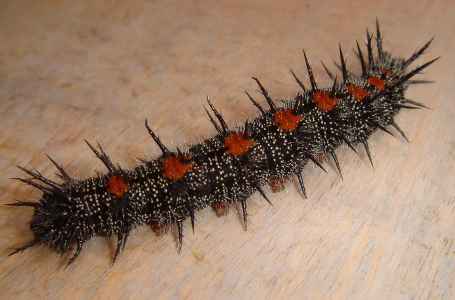
The black spines of the Spiny Elm caterpillar contain toxic substance that can cause skin irritation
The Spiny Elm caterpillar (Nymphalis antiopa) is a striking type of spiny black caterpillar. These black caterpillars from the Nymphalidae order can grow up to 2” (5 cm) in length. This caterpillar turns into the beautiful Mourning Cloak butterfly.
You can identify these stinging caterpillars by the row of bright red or orange dots on their back. There is a jet-black line running up the back that seems to join the dots together. The black segments of the body are covered by clusters of white freckles. The prolegs are also red in color.
The caterpillar stings from sharp-looking black spines poking out from its body. These are surrounded by smaller white bristles
Identifying features
A long black and white caterpillar with red dots and a spiky fuzzy appearance.
- Adult Stage: Spiny Elm Caterpillar transforms into the Mourning Cloak Butterfly (Nymphalis antiopa)
- Host Plants: The caterpillar primarily feeds on elm, willow, and hackberry trees
- Habitat and Distribution: Found in forests, woodlands, and urban areas across North America
White Flannel Moth Caterpillar (Norape ovina)
Another fuzzy stinging caterpillar is the White Flannel caterpillar (Norape ovina). These multi-colored caterpillar has long wispy hairs and tufts of stinging spines.
The caterpillar looks black, yellow, and brown. There is a wide black stripe on its central segments and with brown-colored tips. Rows of yellow dots around each segment give the caterpillar a spotted appearance.
The venomous spines on White Flannel moths can cause a nasty sting. On some people, the inflammation and pain can last for many days and cause allergic reactions.
These caterpillars are found anywhere from Washington DC to Texas, Arizona, and Florida to Mexico and South America.
Identifying features
Look out for a black-looking caterpillar with yellow dots covering its back.
- Adult Stage: White Flannel Moth Caterpillar transforms into the White Flannel Moth (Norape ovina)
- Host Plants: The caterpillar feeds on various plants and trees
- Habitat and Distribution: Found in gardens, forests, and meadows across North America
Southern Flannel Moth (Asp) Caterpillar (Megalopyge opercularis)
One of the most toxic stinging caterpillar species is the Southern Flannel caterpillar (Megalopyge opercularis). This caterpillar gives a nasty bite and is also called a puss moth caterpillar, woolly slug, or Italian asp.
The name of ‘puss caterpillar’ comes from the fact that they look like tiny Persian cats. Due to their painful bite, this species is also called ‘asp’ caterpillars as their bite can be as painful as a snake’s one.
They can range in color from gray-white to dark brown and almost black.
Mostly found in states in the Southern US, these furry caterpillars may look soft but their looks are deceiving. Under the soft fluffy hairs are sharp and stiff spines that are attached to poison glands. When touched, these poisonous spines break off in the skin and cause severe pain.
These furry caterpillars are considered dangerous insects due to their nasty sting. The toxicity of the caterpillar’s sting increases with its body size. Symptoms from the sting of a puss caterpillar can vary in severity and may include headache, nausea, fever, and seizures. Medical attention is advised if symptoms continue to worsen.
Identifying features
A fluffy mound of fur measuring up to an inch (2.5 cm) long with a distinct tail.
- Adult Stage: Southern Flannel Moth Caterpillar transforms into the Southern Flannel Moth (Megalopyge opercularis)
- Host Plants: Puss caterpillars are commonly found on hackberry, elm, plum, sycamore, oak and rose
- Habitat and Distribution: Found in gardens, forests, and urban areas across the southern United States
White-Marked Tussock Caterpillar (Orgyia leucostygma)
One of the most unusual hairy stinging caterpillars you will come across is the White-Marked Tussock moth caterpillar (Orgyia leucostygma).
These are brightly-colored black, yellow, red, and white caterpillars. The segmented caterpillar body has black and yellow stripes running its length. There are red dots on its body along with 4 white tufts of hair.
One feature of the White-Marked Tussock caterpillar are the long hair pencils on each end. At the rear end are prominent red defensive glands with black long tails on either side. At the other end is a dark brown hair pencil pointing at 45 degrees upward.
Although this caterpillar doesn’t sting, the fine hairs (called setae) can cause irritation or allergic reactions.
They feed on tree leaves such as apple, cherry, elm, spruce, rose, and chestnut.
Identifying features
Growing to about 1.3” (3.5 cm) long, these ‘tussock’ caterpillars have an exotic appearance due to their bright colors and unusual tufts of hairs.
- Adult Stage: White-Marked Tussock Caterpillar transforms into the White-Marked Tussock Moth (Orgyia leucostygma)
- Host Plants: The caterpillar feeds on various trees and shrubs
- Habitat and Distribution: Found in gardens, forests, and meadows across North America
Saddleback Caterpillar (Acharia stimulea)
The Saddleback caterpillar (Acharia stimulea) has an angry look that is able to ward off many predators and humans alike. In the Limacodidae family of slug-type caterpillars, the Saddleback has spiny horns that sting.
The identifying feature of the Saddleback is a saddle-like marking on its back. This is a square green patch with a large brown oval central area that is usually bordered with white. The end of the caterpillar also has 2 white dots that resemble menacing eyes.
The sting from Saddlebacks come from the urticating spines on the horns and rest of its body. These venom-filled hairs can cause a painful sting resulting in a rash and possible nausea. You may come across these strange-looking caterpillars when gardening, so handle them with care.
Identifying features
Spiky horns on either end, a saddle marking on its back, and tufts of spines along its side make this an easy caterpillar to identify.
- Adult Stage: Saddleback Caterpillar transforms into the Saddleback Moth (Acharia stimulea)
- Host Plants: The Saddleback caterpillar can be found on deciduous trees such as basswood, chestnut, cherry, oak, and plum, but occasionally, they may feed on corn
- Habitat and Distribution: Found in gardens, forests, and meadows across North America
Crowned Slug Caterpillar (Isa textula)
In the same family as the Saddleback, the Crowned slug caterpillar (Isa textula) looks like a flattened leaf.
Crowned slug caterpillars have an almost spherical green shape. Stinging spines stick out from around the peripheral of the larvae. These spines are more colorful at the head end and can be a deep red rusty color. They gradually fade to white or beige at the tail end.
Although the caterpillar has a flattened shape, a raised ridge in the middle means it is not completely flat. This ridge has 2 yellow lines running up the green body. Yellow and red dots cover this ‘flat-looking’ caterpillar.
Identifying features
A pale green caterpillar with a flattened shape and venomous spines sticking out around its edge.
- Adult Stage: Crowned Slug Caterpillar transforms into the Crowned Slug Moth (Isa textula)
- Host Plants: The caterpillar feeds on a variety of trees and shrubs
- Habitat and Distribution: Found in gardens, forests, and meadows across North America
Spiny Oak Slug Caterpillar (Euclea delphinii)
Another type of green stinging caterpillar is the Spiny Oak slug caterpillar (Euclea delphinii). This is a bright colorful hairless caterpillar that has venomous spikes all over it.
The Spiny Oak slug has flattened look and a number of interesting marking patterns on its back. Colors on these stinging insects are yellow, brown, green, and orange. The back has 2 orange stripes running up it. On either side of these are lime-green markings in circular patterns.
The tufts of toxic spines sticking out around the sides are the stinging part of this caterpillar. There are also venomous horns at either end as well as on the back. Its spiky look and bright colors are signs to humans and predators to stay away.
Identifying features
Bright green and orange colors, a slightly spherical shape, and spiny yellow horns are identification features of this caterpillar.
- Adult Stage: Spiny Oak Slug Caterpillar transforms into the Spiny Oak Slug Moth (Euclea delphinii)
- Host Plants: The caterpillar primarily feeds on oak and other hardwood trees
- Habitat and Distribution: Found in forests and woodlands across North America
Smeared Dagger Moth Caterpillar (Acronicta oblinita)
A long black caterpillar with yellow stripes could be the Smeared Dagger caterpillar (Acronicta oblinita). These long caterpillars with bright colors have spine tufts sticking out all over the body.
The Smeared Dagger moth caterpillar can be described as a black and yellow caterpillar variety. These caterpillars are identified by tufts of grayish-white or sometimes brown spines sticking out from black and white bands that wrap around its body. A light brush against these stinging caterpillars can leave your skin with itchy hives.
These are found as far north as Canada and as far south as Indiana, Texas, and Florida.
- Adult Stage: Smeared Dagger Moth Caterpillar transforms into the Smeared Dagger Moth (Acronicta oblinita)
- Host Plants: The caterpillar feeds on various trees and shrubs
- Habitat and Distribution: Found in gardens, forests, and meadows across North America
Buck Moth Caterpillars (Hemileuca maia)
Some of the spikiest species of caterpillars you will find are the larvae of the Buck moth caterpillar (Hemileuca maia). Although this isn’t a colorful caterpillar, there are jaggy dark spines sticking out all over the place. These are some of the largest stinging caterpillars and can measure up to 2.5” (6.5 cm).
Buck moth caterpillars tend to feed mostly on oak trees. If they feed in large numbers, they can quickly decimate vegetation.
All of the hollow spines contain irritating venom that can cause a painful “bite.” If the spines break off in your skin, poison is slowly released. Although this isn’t enough to kill a person, they can cause severe burning sensations under the skin.
These caterpillars are most prevalent in areas where there are a number of oak trees. States most commonly affected are Louisiana and Virginia.
Identifying features
Predominately black or dark brown in color, most species have faint white markings, tufts of spines, and jaggy venomous horns that identify them.
- Adult Stage: Buck Moth Caterpillar transforms into the Buck Moth (Hemileuca maia)
- Host Plants: The caterpillar feeds on a variety of plants, including oak, hickory, and other hardwood trees
- Habitat and Distribution: Found in forests and woodlands across North America
Monkey Slug Caterpillar or Hag Moth (Phobetron pithecium)
One of the strangest-looking hairy caterpillars is the Monkey slug caterpillar (Phobetron pithecium). This brown-colored caterpillar looks as if it has hairy arms and resembles a squashed hairy spider.
This stinging hairs of this caterpillar can cause skin irritation. In some people, an allergic skin reaction may happen from handling a Monkey slug caterpillar.
- Adult Stage: Monkey Slug Caterpillar transforms into the Hag Moth (Phobetron pithecium)
- Host Plants: The caterpillar feeds on a variety of trees and shrubs including oak, chestnut, dogwood, sassafras and ash
- Habitat and Distribution: Found in gardens, forests, and meadows across North America
Giant Leopard Moth Caterpillar (Hypercompe scribonia)
The Giant Leopard caterpillar (Hypercompe scribonia) is a fuzzy black type of caterpillar with red markings. These larvae belong to the ‘woolly bear’ caterpillars due to their thick-looking coat.
One of the features to help identify a Giant Leopard caterpillar are red bands between its segments. These are often seen when the large caterpillar rolls up into a ball or when it’s moving.
Unlike most varieties of stinging caterpillars, these giant moth caterpillars don’t have urticating spines. The pain from the sting comes from the stiff spines than can prick the skin.
- Adult Stage: Giant Leopard Moth Caterpillar transforms into the Giant Leopard Moth (Hypercompe scribonia)
- Host Plants: The caterpillar feeds on a variety of plants, including dandelion, plantain, and violets
- Habitat and Distribution: Found in gardens, forests, and meadows across North America
Variable Oak Leaf Caterpillar (Lochmaeus manteo)
The name Variable Oak Leaf caterpillar (Lochmaeus manteo) is very appropriate as its colors and markings can change from species to species.
Generally, these are long yellowish-beige caterpillars with brown, white, and yellow patterns along their body. Some brown patterns can resemble an oak leaf. White lines run up the back and along the side. The unusually-shaped head also has white and black stripes on it.
There are very few short spines on this species and it is not a stinging caterpillar. However, care needs to be taken as the crawling caterpillar can spit out acid when under threat. This can cause a burning skin sensation similar to being stung or bitten.
These nasty spitting caterpillars love to gorge on deciduous trees, with oak being their favorite.
- Adult Stage: Variable Oak Leaf Caterpillar transforms into the Variable Oakleaf Moth (Lochmaeus manteo)
- Host Plants: The caterpillar primarily feeds on oak and other hardwood trees
- Habitat and Distribution: Found in forests and woodlands across North America
South American Caterpillar (Lonomia obliqua)
One of the most toxic and deadliest caterpillars is the Giant Silkworm moth or South American Caterpillar (Lonomia obliqua).
These extremely toxic larvae can grow up to 2” (5.5 cm) long and be shades of green or brown. Their bodies are covered with urticating spines that contain potentially deadly poison. Deaths due to coming in to contact with these deadly caterpillars have been reported in Brazil.
Although many caterpillars in the Lonomia genus are stinging caterpillars, it is only the Lonomia obliqua and Lonomia achelous species that are dangerous enough to cause death.
These caterpillars only inhabit countries in Central and South America.
Identifying features
The most dangerous caterpillar on the planet due to its highly toxic venom contained in the spines. It is about 2” (around 4.5 – 5.5 cm) long, with rows of tubercles with spines of different sizes.
- Adult Stage: South American Caterpillar transforms into the South American Moth (Lonomia obliqua)
- Host Plants: The caterpillar feeds on a variety of trees and shrubs
- Habitat and Distribution: Found in forests and woodlands across South America
Hickory Tussock Caterpillar (Lophocampa caryae)

The hairy hickory tussock caterpillar has black patterns along its white back
The larva of the hickory tussock moth is a black and white caterpillar covered in rash-causing tuffs of irritating hairs. Identifying features of the worm-like caterpillar are long white pencil hairs at either end, bands of black dots traversing a white body, and irritating black tufts on its back.
Hickory tussock caterpillars grow up to 1.77” (45 mm). The caterpillars tend to feed in large groups and can completely defoliate willow, pecan, hickory, and walnut trees. However, the gorging white and black caterpillars rarely damage trees entirely.
The urticating tufts can cause skin irritation because the microscopic, barbed spines can lodge in the skin. According to some reports, the caterpillar isn’t venomous, but its stinging spines cause skin reactions like venomous barbs would cause.
Identifying features
The hickory tussock moth is identified by its white body covered in black dots, black tufts of hairs, and soft-looking setae.
- Adult Stage: Hickory Tussock Caterpillar transforms into the Hickory Tussock Moth (Lophocampa caryae)
- Host Plants: The caterpillar primarily feeds on hickory and walnut trees
- Habitat and Distribution: Found in forests and woodlands across North America.
Stinging Caterpillars -FAQ
How long do caterpillar stings last?
The pain, swelling, and burning sensation from a caterpillar sting can last for any time from an hour up to a few days. If allergic reactions occur, you should seek medical attention. It is also important to take a good description of the type of caterpillar that stung you.
What do stinging caterpillars turn into?
Like all caterpillars, species of stinging caterpillars turn into beautiful butterflies and moths.
What happens if you touch a fuzzy caterpillar?
It depends on the species of caterpillar. Some furry caterpillars or ones with horns are completely harmless. Other types of hairy caterpillars have urticating spines that can irritate the skin and may release poison.
What should you do if you are stung by a caterpillar?
You can use some sticky tape to carefully remove the barbed spines or hairs. You are also advised to seek medical attention if any severe reaction or allergic reaction occurs.
Do Hairy Caterpillars Bite?
Although caterpillars have jaws to feed on leaves and other insects, they don’t bite people. Usually, when someone refers to a caterpillar bite, they are talking about a caterpillar sting.
What is the Most Venomous Caterpillar?
The most venomous caterpillar is often considered to be the larval form of the Lonomia genus of moths, particularly the species Lonomia obliqua, commonly known as the South American or giant silkworm moth. This caterpillar is found in South America, primarily in countries such as Brazil and Argentina.
The venom of the Lonomia obliqua caterpillar contains a powerful anticoagulant that can lead to severe internal bleeding, which can be life-threatening if not promptly treated. Contact with the spines of this caterpillar can cause intense pain, swelling, and other severe allergic reactions.
Related articles:


